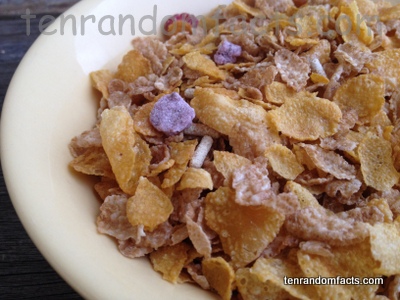Remember to eat some breakfast cereal for a healthy start to your day!
- Breakfast cereal, also known as ‘cereal’, is a processed grain-based food, usually eaten during the morning, often as the first dish of the day.
- Breakfast cereal can be eaten both cold or hot, with milk, fruit, yoghurt and sometimes sweeteners added, and it is generally considered as a healthy breakfast option, however, some ready-to-eat cereals are high in sugar.
- Read-to-eat breakfast cereal has been the subject of a constant increase in popularity, and over 500 cereals or variations have been manufactured throughout the world.
- Porridge, a type of breakfast cereal, has been eaten since ancient times, and is made of ground, chopped or rolled oats, rice, corn, barley, semolina, wheat or other grains.
- It is likely that the 1863 Granula breakfast cereal produced by a nutritionist from the United States, James Jackson, was the first to be invented, although the item required a period of soaking before consumption, making it impractical.
- Breakfast cereal was originally scooped from large barrels for each customer, and around the late 1800s it started to become prepackaged in boxes that helped to increase its popularity.
- Breakfast cereal was popularised around the late 1800s by the American, John Kellogg, a physician and the cofounder of Kellogg’s, along with his brother William, as well as Charles Post, a salesman who became a cereal manufacturer after visiting Kellogg’s sanitarium.
- Breakfast cereal is available in a wide variety of shapes and colours, but is typically flaky or grainy in texture, and is generally brown to orange in colour, depending on the ingredients.
- Breakfast cereal often has a high content of fibre, as well as many added vitamins, although some cereals contain a substantial quantity of sugar.
- Breakfast cereal can be targeted specifically towards adults or children, and is often more sophisticated and healthy for adults, but sweeter, bright and more colourful for children.
Bibliography:
Avey T, What’s for Breakfast? Discover the History of Cereal, 2012, PBS, http://www.pbs.org/food/the-history-kitchen/history-of-cereal/
Breakfast Cereal, 2014, Wikipedia, http://en.wikipedia.org/wiki/Breakfast_cereal
History of Cereals, 2014, Ceereals, http://www.ceereal.eu/asp2/why_breakfast/l1.asp?doc_id=420






